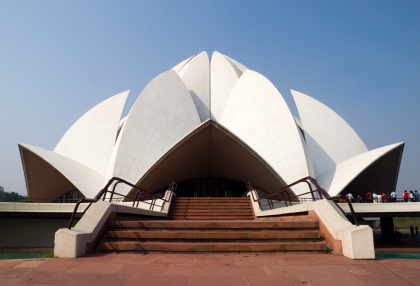Will it open or not? And if it opens, will we see a ray of light rising to the sky? Unless of course it takes the opposite route, from the heavens to the interior of the building.
Light or not, you feel like something’s about to happen, that the building’s alive, that you’re going to make contact. No, it’s not a spaceship; it’s infinitely more poetic.

We are at the Lotus Temple in New Delhi, the capital of India. The temple belongs to the Baha’i community and its real name is the Baha’i House of Worship.
The Baha’i religion includes seven million members in 189 countries around the world. If you like botany, you’ll easily make the link when observing the building, which is in the form of a lotus, from which it derives its name. As Wikipedia explains, the lotus is the only aquatic plant whose flower is above the water, unlike water lilies and its relatives whose flowers float on the water.
The Lotus Temple symbolizes openness to the universe and, even better, the blossoming of a flower. Ultimately it symbolizes the blossoming of a human being.
The building is composed of 27 petals that form nine sides, all covered in marble. Under the exterior petals are found the various rooms: reception, the library, exhibit halls and conference rooms. Nine ponds surrounding the building evoke the natural environment in which lotus flowers grow. Nine doors open onto a central hall capable of holding up to
2,500 people. You see that the number nine is very significant to the Baha’i community.
The temple and immense garden surrounding it comprise 26 acres. The building was designed by Iranian architect Fariborz Sahba, who now lives in Canada.
The Lotus Temple is far more than a religious building. It’s one of the most visited tourism sites on the planet. Its image has been photographed, published, posted and circulated around the world, and the building has received a number of architectural awards.
According to Wikipedia, the temple receives 13,000 visitors a day—about nine every minute.
Photo: iStockphoto
References: Wikipedia.